Review and photographs by Rajvinder “IrritatorRaji” Phull, edited by Suspsy
I, like many others, can thank Jurassic Park for fuelling my love of dinosaurs. However, I feel very few people can thank the video game Jurassic Park: Operation Genesis for kick-starting an adoration for Ouranosaurus. “Exotic,” “fun-loving,” these were words that forever shaped my view of it. For me, the species had always felt like more than just an Iguanodon-looking dinosaur with a sail. I never saw it as just fodder for the bigger and badder Carcharodontosaurus or Spinosaurus. For me, Ouranosaurus had always been some sort of embodiment of grace and strength, especially considering its unique appearance and ability to thrive despite its less-than-friendly neighbours. So when PNSO released their colourful take on this “Brave Lizard” I was more than excited.
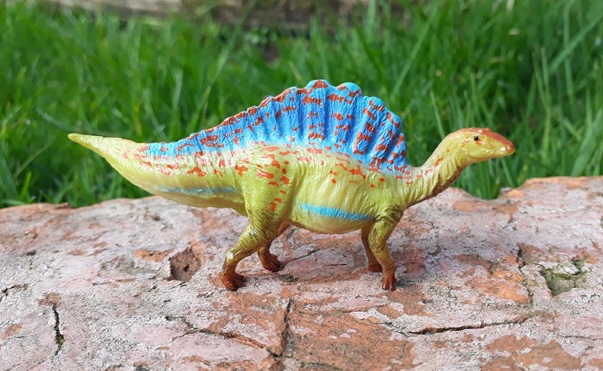
Measuring in at around 8.6 cm (3.4 inches) long from nose to the tip of the tail and 4 cm (1.6 inches) at the top of sail, this figure is downright tiny, though that’s far from a bad thing and definitely doesn’t take away from its overall quality. If anything, I think its tiny size works very well for this figure, especially considering the vibrant colours that it boasts. These colours are made better by having them in moderation. So instead of having a large, neon yellow dinosaur that burns your retinas, we’ve a delightful splash of yellow and blue that catches the eye rather than offends it.
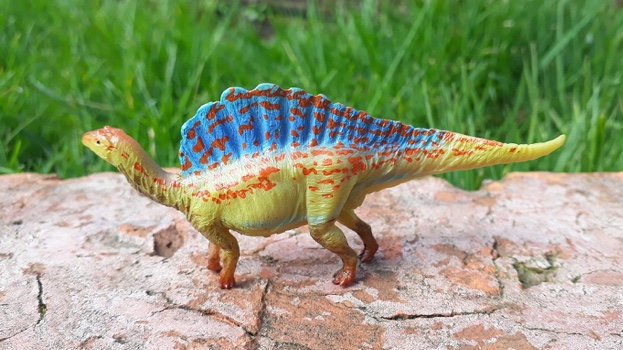
The Ouranosaurus stands very easily on its own four legs. I don’t have any balancing issues with it whatsoever. And the pose is great. Calmly wandering, tail swishing gently, and head looking off to the right, this animal looks as it’s calmly surveying the area. Completely at ease with its surroundings, yet on high alert for anything with a killer appetite. Another reason as to why I appreciate the pose is because the calm and relaxed nature of the animal’s stance offsets the bold, bright, and lively colour scheme. The colours are a little bit wild, but that subdued, natural posture helps to ground this figure back into reality.

The colour scheme is definitely something unique and is probably a love-it-or-hate-it kind of paint job. The body of the animal is coloured a vibrant yellow with a light blue stripe running down both flanks. Orange splotches run down from the neck, right down the body, all throughout the sail, and end at the tail. The same orange colour runs down the top of the animal’s head and neck. A dark brown wash can be found along the base of the neck and on the legs. The sail is a bright blue and the thighs, though very hard to see, are ever so slightly green. The eyes are painted a simple black, which is to be expected for a figure this small. To be completely honest, I’m on the fence in regards to my thoughts on this colour scheme. On the one hand, the bright yellows and blues with a splash of orange really do scream “exotic.” The yellow body with orange specks reminds me of a sandy desert. Very reminiscent of modern day northern Africa. The sail reminds me of a clear blue sky, which makes sense given that Ouranosaurus is alternatively known as “Sky Lizard” after the Greek god of the sky, Ouranos. This combination of vibrant colours would most certainly help it to stand out among the crowd, which may be a reason as to why one may dislike the colour scheme. You could argue that it’s too bright and, for a prey animal, the last thing Ouranosaurus would want to do is stand out.
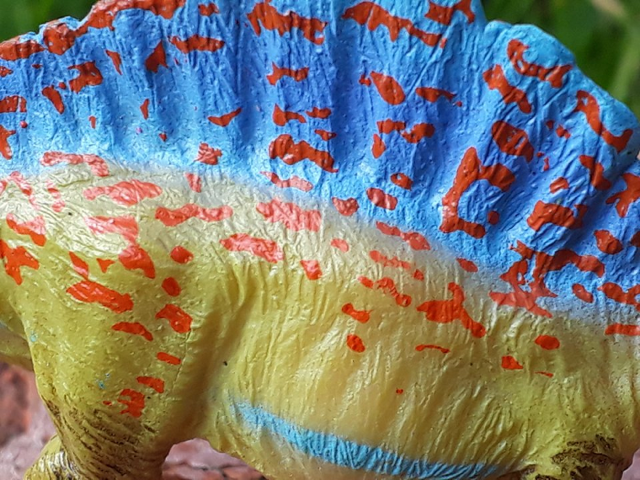
For a figure of this size, the sculpting is nothing short of amazing. Scales are not present, but that’s to be expected as, if you shrunk a real Ouranosaurus down to a few inches long, you probably wouldn’t be able to see its scales either. But what it lacks in reptilian scales, it makes up for in an abundance of wrinkles and musculature, which really add a lot of varied texture to the skin. Small details you probably wouldn’t expect to find here, such as the nostrils and ears, are indeed present on this figure. The animal’s toes are all there, as is the thumb claw. One small detail that is missing from the sculpt is the cloaca.
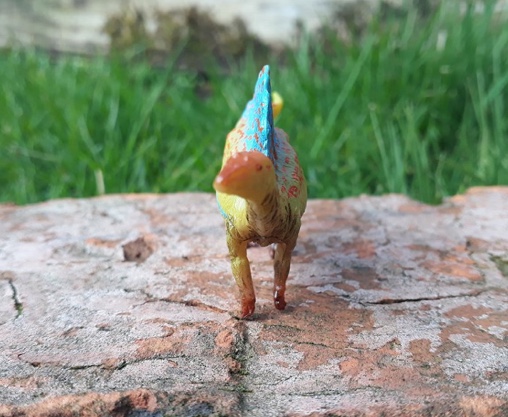
For the most part, this figure is scientifically solid. There is hardly any shrink wrapping, no hand pronation, no neck or tail breaking for the sake of striking an elaborate pose, and you get the idea. At first glance, there’s not much to complain about. However, there are few anatomical issues with this figure. Firstly, with what is perhaps the most obvious issue, is the shape of the skull. The skull of Ouranosaurus was rather flat and elongated, much longer than the skull of its relative Iguanodon. The beak of Ouranosaurus was also rather wide. With this figure, the skull is rather small and narrow towards the end, being more tear-drop shaped and rounded. The head looks slightly too small for the body and also seems to be missing a beak. The nostrils are also too far forward, being placed right at the end of the snout instead of being slightly further along and placed higher up on the skull.
Secondly, I feel the forearms look little too thin and flimsy. Ouranosaurus is estimated to weigh in at somewhere between two to four tonnes; an animal that heavy would need very powerful and muscular legs to support that weight. That being said though, this may just be a personal nitpick as I’ve seen paleoart and restorations with similar forearm sizes.
And lastly, the tail feels too thin. Ouranosaurus was an animal that probably had to run for its life fairly often, and in order to carry its immense weight and propel its hind legs forward and back, it would have needed some serious muscle power. The caudofemoralis longus is a large muscle, found in almost all animals with a tail, that connects from the femur to the tail vertebrae. In an animal like Ouranosaurus, this muscle may have likely been fairly large in order to support the life it led, and, as a result, would have made the tail appear to be very wide and bulky. This muscle is actually present on the model, you can definitely feel it running your fingers down the tail, but it is very small and looks rather weak and undeveloped.
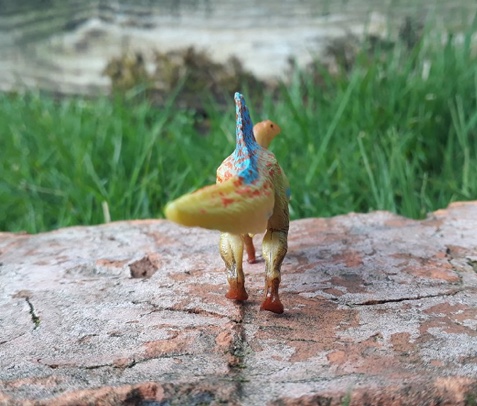
In regards to issues with the figure itself, there aren’t really any major faults to complain about. The seam lines are very nicely managed and, in some spots, are nearly impossible to notice. Seams are somewhat more noticeable in places you might not pay much attention to, such as the underside of the figure and around the legs, but only because the brown wash highlights them. The only feature I can see becoming an issue are the forelimbs. As I mentioned earlier, they’re quite thin, and I imagine they’re particularly vulnerable to warping. The packaging this figure comes in has no plastic wedge in between the legs to prevent them from curling inwards, meaning your brand new figure could already have warped limbs before you’ve even opened the package. My best advice would be to display this figure where the sun can’t reach it, or in a room where the temperature will never be too high.
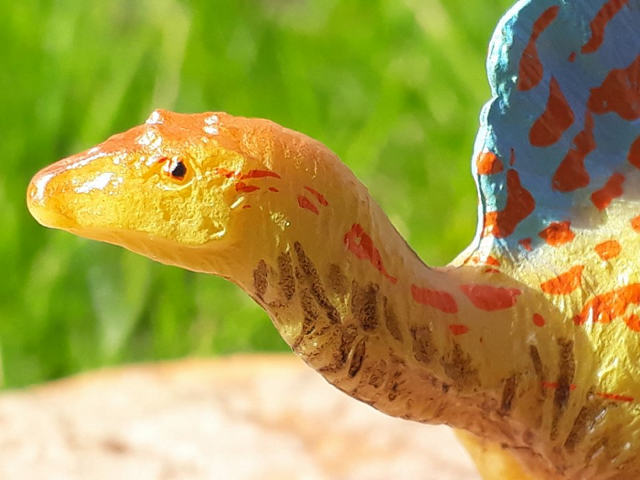
So what’s my final verdict? It’s a very nice interpretation of Ouranosaurus, but not the best. For someone like myself who sees dinosaurs, especially this one, as “exotic” and “colourful,” this figure would be a welcome addition to your collection. And, for its asking price (£3.99 in the UK, $6 in the US), it’s pretty good value. But if the size and inaccuracies put you off this Ouranosaurus, then you may be better off hunting down Battat’s version. However, if this figure interests you, I’d advise you pick one up soon as its manufacturer, PNSO, has imploded and faces an incredibly uncertain future. So you’d be best to get one soon before it potentially becomes rare and expensive.
Disclaimer: links to Ebay and Amazon on the DinoToyBlog are affiliate links, so we make a small commission if you use them. Thanks for supporting us!





It is a great paleoartistic work that ouranosaurus of PNSO. What was said by Suspsy is a pity that this company has imploded more when it was a promising company and with an advisor and co-founder like Zhen Chuang (excellent paleoartist whose paintings of prehistoric animals in particular dinosaurs are outstanding) that could have contributed much to the figure of collecting (resin) and toy / collecting (PVC).
I recommend I also buy that type of figures then they will become very expensive. Apart from that they have a pretty good identification role.
Very nice review, Rajvinder, wanted to write one myself and got the photos on my PC for way over a year, but your review is most fitting for the figure.
“Hunting down Battat’s version” is eaiser said than done and while I agree that it is the superior sculpt, I honor my tiny shiny PNSO Ouranosaurus for being the best representation of that unique animal available 😀